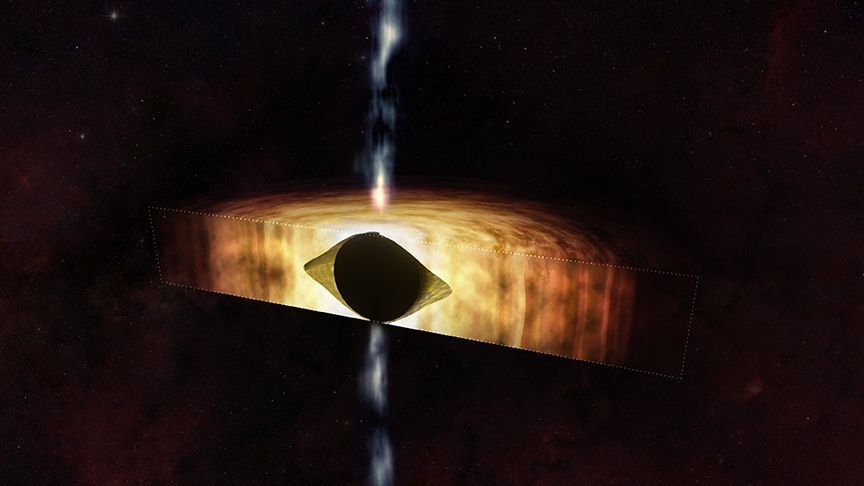The supermassive black hole at the center of our Milky Way galaxy is spinning so fast that it is warping spacetime into an oval shape reminiscent of an American football (or a rugby ball for any non-American readers!. The finding comes from a careful study of radio and X-ray observations.
According to Albert Einstein‘s theory of general relativity, when a massive object is spinning, it can drag spacetime around with it. This phenomenon is called “frame dragging,” and even our spinning Earth has been observed to warp spacetime in its vicinity. However, the effect is far more pronounced for extremely massive objects, aka supermassive black holes that are many millions or even billions of times more massive than our sun. And the more quickly such a massive object spins, the more spacetime flattens around it, thereby adopting that oval-shape.
However, the spin-rate of our galaxy’s 4.1-million-solar-mass black hole, which is called Sagittarius A* or Sgr A* for short, has been difficult to pin down. Most estimates have varied widely. A group of astronomers, led by Ruth Daly of Penn State University, has now applied a procedure called the “outflow method” to get a measure of Sgr A*’s angular velocity — that is, how many times it spins per second.
Related: Event Horizon Telescope spies jets erupting from nearby supermassive black hole
The outflow method is quite literally named — it measures how material is flowing away from a black hole, which might at first seem counterintuitive as black holes are more well-known for pulling material in. Yet, an outflow from a black hole can come in the form of a magnetically collimated jet of matter that emits copious radio waves. Meanwhile, hot clumps of plasma (ionized gas) produced in the disk of matter around a black hole, and which can then drift away, are hot enough to radiate in X-rays. These clumps, called plasmoids, form more efficiently when a black hole is spinning rapidly because the resulting frame-dragging amplifies the black hole’s magnetic field and tightens it like a belt closer to the black hole’s periphery. In turn, this creates magnetically intense conditions more conducive to plasmoid formation.
So, by going back to archival observations of Sgr A* made with the Karl G. Jansky Very Large Array of radio telescopes and NASA’s Chandra X-ray Observatory, Daly’s team measured the angular velocity of Sgr A* to be 60% of the maximum possible value, which is defined by the speed of light. In other words, Sgr A* is spinning very fast, quick enough to warp spacetime into a flattened oval shape.
“Our work may help settle the question of how fast our galaxy’s supermassive black hole is spinning,” said Daly in a statement. “Our results indicate that Sgr A* is spinning very rapidly, which is interesting and has far-reaching implications.”

These implications relate to the past and possible future activity of Sgr A*. The faster a black hole spins, the more powerful the collimated jets of radiation it emits as particles in the hot disk of matter swirling around the black hole are swept up and spat out. Currently, Sgr A* is barely active, but the infall of an unfortunate gas cloud or star could refuel its jets. Evidence that this has happened in the past comes from what are called the Fermi Bubbles, which are two humungous structures of gamma-ray emitting matter stretching above and below the plane of our galaxy, spanning 50,000 light years in total and centered on Sgr A*. The belief is that the Fermi Bubbles are remnants of powerful jets that once blasted out from the black hole, but such powerful jets could only arise if Sgr A* is spinning rapidly.
Structures such as the Fermi Bubbles are able to excavate gas from a galaxy, careening through star-forming material like a snow plow.
“Jets powered and collimated by a galaxy’s spinning central black hole can profoundly affect the gas supply for an entire galaxy, which affects how quickly and even whether stars can form,” said Megan Donahue of Michigan State University in the same press statement. “The Fermi Bubbles seen in X-rays and gamma rays around our Milky Way’s black hole show the black hole was probably active in the past. Measuring the spin of our black hole is an important test of this scenario.”
The results were published in the Jan. 2024 issue of the journal Monthly Notices of the Royal Astronomical Society.

Dr. Thomas Hughes is a UK-based scientist and science communicator who makes complex topics accessible to readers. His articles explore breakthroughs in various scientific disciplines, from space exploration to cutting-edge research.








